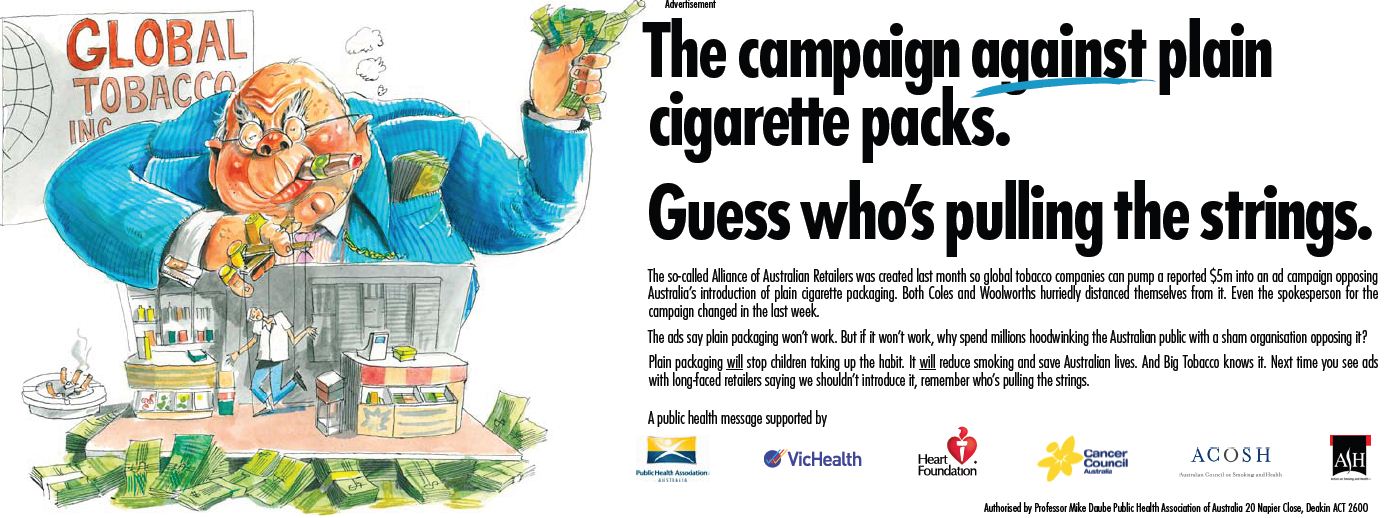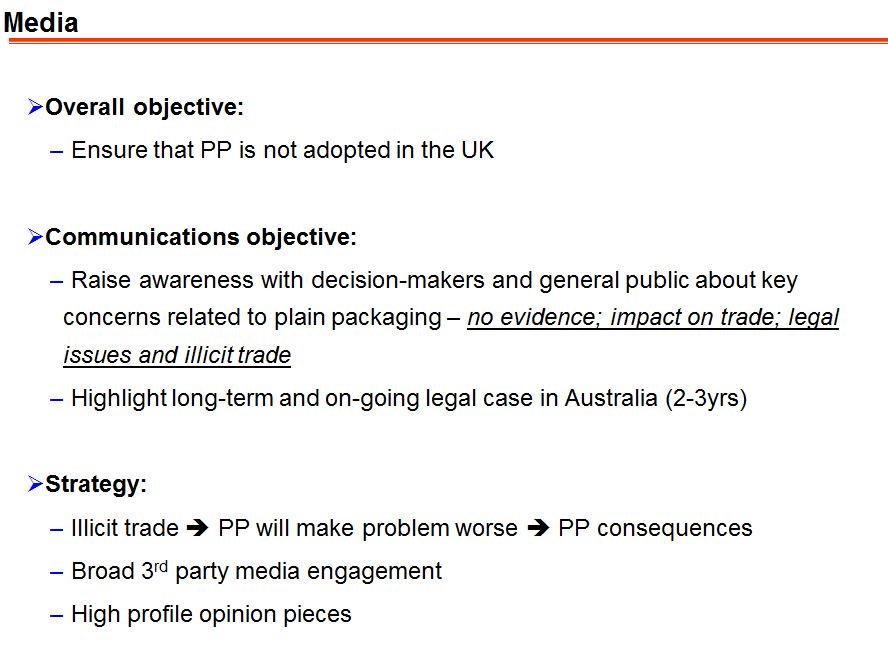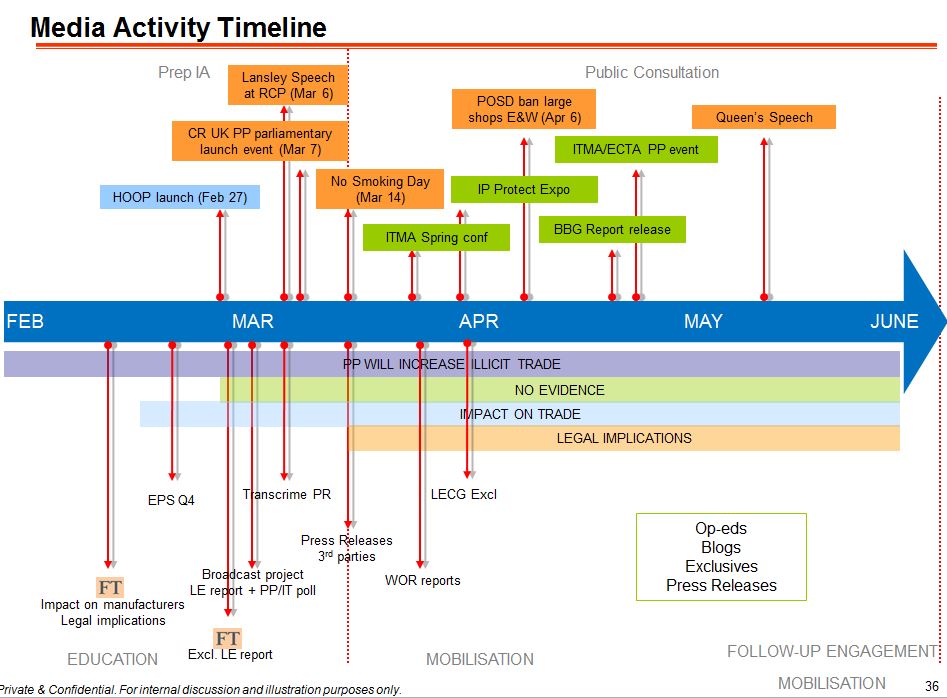Details and examples of the media campaigns and interference tactics used by the tobacco industry are given on the OPPOSING ARGUMENTS (and how to counter them) pages of the Tools and Resources. These demonstrate how the industry arguments are flawed, often lacking any rational basis, and set out the counter arguments that can be used to combat the industry campaigns. That section highlights the industry’s use of experts that lack independence and whose evidence does not meet basic standards; as well as the fact that the industry has never disclosed any of its own consumer research into the likely impacts of plain packaging.
In addition, the POLICY BRIEFS in the Tools and Resources includes a short paper that sets out the main counter arguments to each of the key arguments used by the industry, which can be given to politicians or the media.
Details and examples of the media campaigns and interference tactics used by the tobacco industry are given on the OPPOSING ARGUMENTS (and how to counter them) pages of the Tools and Resources. These demonstrates how the industry arguments are flawed, often lacking any rational basis, and sets out the counter arguments that can be used to combat the industry campaigns. That section highlights the industry’s use of experts that lack independence and whose evidence does not meet basic standards; as well as the fact that the industry has never disclosed any of its own consumer research into the likely impacts of plain packaging.
In addition, the POLICY BRIEFS in the Tools and Resources includes a short paper that sets out the main counter arguments to each of the key arguments used by the industry, which can be given to politicians or the media.
These campaigns oppose plain packaging in every country that has proposed or considered the policy. These campaigns go much further than the typical opposition to tobacco-control measures. With plain packaging, the industry campaigns have used:
- full-page advertisements in national newspapers
- billboard campaigns
- dedicated websites setup to promulgate the tobacco industry’s views
- social media
- short films
- strong political lobbying at all levels
- street-level campaigning and surveys
- heavy use of proxy organizations or front groups , and
- in Sweden, JTI even set up a whole fake super market at a political convention, where all the goods (coffee, bread, milk, etc.) were in plain packaging
These campaigns have the potential to be effective in swaying public opinion and some parts of government. The reason the tobacco industry is so vehemently opposed to plain packaging is because the policy works.
The tobacco industry’s arguments opposing plain packaging are now well established and vary little from one country to another, although the focus can be different. For instance, in France, the tobacco retailers (backed by the industry) generated much of the opposition with the argument that it would lead to job losses. Where as in Slovenia, the argument that it would increase illicit trade and fund criminal gangs was used more. But the industry has no hesitation in recycling arguments in multiple jurisdictions, even after they have been wholly discredited elsewhere.
- There is no evidence that plain packaging will work
- It will increase the illicit trade in tobacco – because plain packs are easier to counterfeit
- It is the start of a slippery slope or domino effect – leading to plain packaging of other products
- It will breach intellectual property laws – leading to huge compensation claims
- It will lead to price reductions – thereby increasing consumption
- It will increase costs for small retail businesses – by increasing consumer transaction times
- It will cause job losses in domestic tobacco manufacturing industries
These arguments are largely made by mere assertion, with no evidence to back them up, and can be easily refuted by using available evidence and judgments from decided legal cases. See the POLICY BRIEFS: Industry Arguments in the Tools and Resources for a series of short counter arguments to the industry’s claims.
To date, no empirical studies conducted by, or on behalf of, tobacco companies have been published. The tobacco companies have refused to disclose any of their own consumer research or behavioural studies into the impacts of plain packaging.
Where the tobacco companies have sought to use experts to support their arguments, for instance, in the High Court legal challenge to the UK plain packaging regulations, the Court strongly criticised the experts describing their evidence as “not peer reviewed”, “frequently unverifiable” and failing to “accord with internationally recognized best practice”
An important aspect of progressing any tobacco-control policy and in particular plain packaging, is for governments and civil society to prepare a strategy to both pre-empt and respond to tobacco-industry interference:
- Anticipate the likely arguments by the tobacco industry and prepare the counter arguments at an early stage.
- Directly refute the industry arguments before the industry has a chance to promulgate them.
- Use pre-prepared briefing papers covering key issues for the media, other government departments and interested members of parliament (See the POLICY BRIEFS in the Tools and Resources).
- Generate positive media campaigns that include information about the global movement towards adopting the policy and the positive results from Australia.
- Engage early with other government departments (see GUIDE 4.1: Coordinate across government).
- Seek endorsements the use of local and international experts, including prominent doctors, to speak to the media and other government departments about tobacco's harms and the real facts about plain packaging ios highly advisable.
- Launch a civil society media campaign supporting the policy, setting out the facts and shining a light on the industry’s tactics.
These bodies can play an important role in countering the arguments put forward by the tobacco industry by organising positive publicity campaigns to promote plain packaging in a way that it may not be possible for government to do while it is going through the policy development and decision making process. Medical and public health bodies can make their views known about the evidence and provide credible experts to speak with the media. Organisations can pre-empt the tobacco industry opposition by engaging with the media ahead of any government announcement to provide the real facts in anticipation of the false opposing arguments the industry and its front groups will put forward.
Cancer Research UK led the campaign to promote plain packaging in the UK. A useful insight into civil society action can be found on their blog post, which provides thirteen steps that shaped the successful campaign including sending flashy cigarette packs to MPs and attending political party conferences. 2
The post-implementation evidence from Australia as to what actually happened after implementation is extremely useful in combatting many of the false tobacco industry claims about the negative impacts of the plain packaging.
| Industry claims before implementation | Australia’s post–implementation evidence |
|---|---|
| Retailer confusion and loss of trade | Quick adaptation by retailers – consumer transaction times actually reduced after implementation and there was no decline in use of small retailers. |
| Explosion in use of illicit tobacco | No detectable changes in major indicators pre-versuss post-implementation. No counterfeit plain packs discovered. Reduced use of unpackaged tobacco. |
| Reduction tobacco prices | Tobacco price increase across all sectors. |
| Increase consumption | Continuing decline in overall consumption and significant reductions in smoking prevalence rates. |
Key facts about the research evidence and studies that demonstrate these post
implementation results can be found on the Cancer Council Victoria website:
http://www.cancervic.org.au/plainfacts/browse.asp?ContainerID=industryopposition
The tobacco companies regularly say different things in different contexts. Highlighting this can be an effective means of countering their arguments. For instance, in the industry challenge to the UK regulations, the tobacco companies sought to argue that branding on packaging is not the same as advertising and has a different function. However, in the challenge before the High Court of Australia, the tobacco companies made a direct comparison between the space on the packets for branding and advertising billboards (see the CASE SUMMARIES page of the Tools and Resources).
Another example of this relates to illicit trade. Philip Morris International claimed that branded packaging is difficult or impossible to counterfeit when arguing against plain packaging but at the same time, confirmed that branded packaging is easy to counterfeit in a 2012 brochure on Codentify (a track-and trace-system developed by PMI). A report by into illicit tobacco in Australia commissioned by Philip Morris Limited confirms that no counterfeit plain packs have been identified since implementation. The KPMG report is the only statistical evidence the industry uses to support its contention that plain packaging increases illicit trade but the methodology was so flawed that the industry did not use it (or any other evidence) to support that argument in its legal challenge to UK plain packaging regulations.
| “Tobacco manufacturers go to great lengths to design overt authentication features that are difficult, if not impossible, for counterfeiters to imitate.”3 [2012] | “[Cigarette packs] are easily counterfeited, despite the inclusion of innovative holograms, special inks and elaborate design details. Evidence shows that counterfeiters can make copies of even the most sophisticated paper stamps in three weeks.”4 [2012] |
| “Plain packs will be easier to counterfeit.”5 [2012] | “. . .none of the counterfeit packs collected as part of the Empty Pack Survey [in Australia] were in plain packaging.”6 [2015] |
| “KPMG has concluded that illicit tobacco in Australia has reached record levels . . . KPMG’s methodology is widely accepted.”7 [2014] | “The Tobacco Claimants submit that standardised packaging would increase illicit trades. But they have conducted no material analysis or evidence (that they are prepared to place before the Court) of the impact on illicit trades. . .”8 [2016] |
FRONT GROUPS. The tobacco industry regularly establishes and finances front groups or co-opts third-party organizations, such as think tanks or libertarian groups, often via public relations agencies, which are then used to give the impression of broad support for the opposing arguments. For instance, when plain packaging was proposed in Australia, a front group was established, which claimed only to represent the retail industry. However, internal documentation about this group and other industry counter measures were leaked to the media, revealing that the group was receiving support from several tobacco companies.10

In the UK, a university study showed three-quarters of the organizations outside the industry had direct financial links to one or more of the big four tobacco companies, and these were responsible for 60% of the anti-plain packaging campaigning identified. The study, found that organizations that actively opposed plain packaging (including campaigners and business groups) rarely reported any relationship with tobacco companies transparently.11
SOPHISTICATED AND WELL PLANNED CAMPAIGNS. In 2013, leaked internal tobacco industry documents, including power points, revealed the inner-workings of Philip Morris International’s anti-plain packaging campaign in the UK during the previous year. The two examples of slides shown below demonstrate PMI’s key media messages and the sophisticated and detailed timeline planning of which arguments to use and when. Other parts of the documents demonstrate the use of third parties to promulgate the messages.12


1The tobacco tacticswebsite detailing the use of the media by the tobacco industry opposing plain packaging in the UK is available from: www.tobaccotactics.org /index.php/Plain_Packaging_Opposition_in_the_UK; see also Simon Chapman, “Removing the Emperor’s clothes,” which includes a section that describes the campaigns in Australia: http://ses.library.usyd.edu.au//bitstream/2123/12257/7/9781743324295_Chapman_RemovingtheEmperorsClothes_FT.pdf.
3Philip Morris Internationalresponse to the 2012 UK consultationon standardised packaging of tobacco products: Available from: www.pmi.com/eng/tobacco_regulation/submissions/documents/Submission%20and%20All%20Annexes%20(combined).pdf p.21.
4Philip Morris International,Codentify,Brochure, 2012. Available from: www.pmi.com/eng/documents/Codentify_E_Brochure_English.pdf
5See note 2.
6KPMG Illicit Tobacco in Australia Full Year Report 2015, commissioned by Philip Morris, BritishAmerican Tobacco, and Imperial Tobacco, et al., p.44.
7Philip Morris Limited Response to the consultationon “standardised packaging”, August 7, 2014.
8. Judgment in tobacco industry challenge to UK regulationsR (BritishAmerican Tobacco & Ors) v. Secretary of State for Health [2016] EWHC 1169 (Admin) at paragraph 669.
9WHO (2008), Tobacco industry interference with tobacco control is available from: http://apps.who.int/iris/bitstream/10665/83128/1/9789241597340_eng.pdf p.5.
10See www.tobaccotactics.org/index.php/Main_Page.
11See http://medicalxpress.com/news/2016-10-lid-big-tobacco-campaigning-methods.html.
12See http://tobaccotactics.org/index.php/PMI%E2%80%99s_Anti-PP_Media_Campaign
